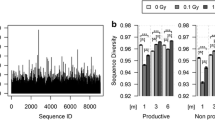Abstract
The effect was studied of a low dose ofγ-ray preexposure on the frequency and molecular spectrum of radiation-induced mutations at the hprt locus in a human T-cell leukemia line. When the cells were preexposed to 0.01 Gy ofγ-rays, the yield of mutations induced by a subsequent 2-Gy challenge dose was reduced by 60%, compared with the 2 Gy of irradiation alone. The data of Southern blot analysis showed that 47% of the mutants induced by 2 Gy in the cells without low-dose preexposure were of the deletion or rearranged mutations type. In contrast, in the low-dose radioadapted cells the proportion of this type of 2-Gy-induced mutations decreased to 28%. This is close to the control level (22%) of spontaneous mutations. Our results confirm that a low dose ofγ-ray preexposure leads to a decreased susceptibility to gene deletions and rearrangements after high-dose irradiation.
Similar content being viewed by others
References
Aghamohammadi SZ, Savage JRK (1991) A BrdU pulse double-labelling method for studying adaptive response. Mutat Res 251:133–141
Bosi A, Olivieri G (1989) Variability of the adaptive response to ionizing radiation in humans. Mutat Res 211:13–17
Cai L, Liu SZ (1990) Induction of cytogenetic adaptive response of somatic and germ cells in vivo and in vitro by low-dose X-irradiation. Int J Radiat Biel 58:187–194
Ikushima T (1987) Chromosomal response to ionizing radiation reminiscent of an adaptive response in cultured Chinese hamster cells. Mutat Res 180:215–221
Kelsey KT, Memisoglu A, Frenkel D, Liber HL (1991) Human lymphocytes exposed to low doses of X-rays are less susceptible to radiation-induced mutagenesis. Mutat Res 263:197–201
Liber HL, Call KM, Little JB (1987) Molecular and biochemical analysis of spontaneous and X-ray-induced mutations in human lymphoblastoid cell. Mutat Res 178:143–153
Morgan TL, Fleck EW, Poston KA, Denovan BA (1990) Molecular characterization of X-ray-induced mutation at the HPRT locus in plateau-phase Chinese hamster ovary cells. Mutat Res 232:171–182
Nussbaum RL, Crowder WE, Nyhan WL, Caskey CT (1983) A three allele restriction-fragment-length polymorphism at the hypoxanthine phosphoribosyltransferase locus in man. Proc Natl Acad Sci USA 80:4035–4039
Oberly TJ, Bewsey BJ, Probst GS (1987) A procedure for the CHO/HGPRT mutation assay involving treatment of cells in suspension culture and selection mutants in soft-agar. Mutat Res 182:99–111
Olivieri G, Bodycote J, Wolff S (1984) Adaptive response of human lymphocytes to low concentrations of radiative thymidine. Science 223:594–597
O'Neill JP, Hunter TC, Sullivan LM, Nicklas JA, Albertini RJ (1990) Southern blot analyses of human T lymphocyte mutants induced in vitro by gamma irradiation. Mutat Res 240:143–149
Rigaud O, Papadopoulo D, Moustacchi E (1993) Decreased deletion mutation in radioadapted human lymphoblasts. Radiat Res 133:99–101
Sambrook J, Fritsch EF, Maniatis T (1989) Molecular cloning. In: Isolation of high-molecular-weight DNA from mammalian cells. Cold Spring Harbor Laboratory Press, Cold Spring Harbor, NY, pp 9.19–9.22
Samson L, Cairns J (1977) A new pathway for DNA repair in Escherichia coli. Nature 267:281–283
Sanderson BHS, Morley AA (1986) Exposure of human lymphocytes to ionizing radiation reduces mutagenesis by subsequent ionizing radiation. Mutat Res 164:347–351
Sankaranarayanan K, Duyn AV, Loos MJ, Natarajan AT (1989) Adaptive response of human lymphocytes to low-level radiation from radioisotopes of X-rays. Mutat Res 211:7–12
Shadley JD, Dai GQ (1992) Cytogenetic and survival adaptive response in G1 phase human lymphocytes. Mutat Res 265:273–281
Shadley JD, Wolff S (1987) Very low doses of X-rays can cause human lymphocytes to become less susceptible to ionizing radiation. Mutagenesis 2:95–96
Thacker J (1986) The nature of mutations induced by ionizing radiation in cultured hamster cells. Mutat Res 168:267–275
Vijayalaxmi G, Burkart W (1989) Resistance and cross-resistance to chromosome damage in human lymphocytes adapted to bleomycin. Mutat Res 211:1–5
Walker GC (1985) Inducible DNA repair systems. Annu Rev Biochem 54:425–457
Wang ZQ, Saigusa S; Sasaki MS (1991) Adaptive response to chromosome damage in clutured human lymphocytes primed with low doses of X-rays. Mutat Res 246:179–186
Whaley JM, Little JB (1990) Molecular characterization of hprt mutants induced by low-and high-LET radiation in human cells. Mutat Res 243:35–45
Wiencke JK, Afzal V, Olivieri G, Wolff S (1986) Evidence that the [3H] thymidine-induced adaptive response of human lymphocytes to subsequent doses of X-rays involves the induction of a chromosomal repair mechanism. Mutagenesis 1:375–380
Wolff S (1992) Low-dose exposures and the induction of adaptation. In: Sugahara T, Sagan LA, Aoyama T (eds) Low dose irradiation and biological defense mechanisms. Elsevier, Amsterdam, pp 21–26
Wolff S, Afzal V, Wiencke JK, Olivieri G, Michaeli A (1988) Human lymphocytes exposed to low doses of ionizing radiation become refractory to high doses of radiation as well as chemical mutagens that induced double strand breaks in DNA. Int J Radiat Biol 53:39–48
Zhou PK, Sun WZ, Liu XY, Zhang YP, Wei K (1992) Adaptive response of mutagenesis and DNA double-strand break repair in mouse cells induced by low dose ofγ-rays. In: Sugahara T, Sagan LA, Aoyama T (eds) Low dose irradiation and biological defense mechanisms. Elsevier, Amsterdam, pp 271–274
Zhou PK, Liu XY, Sun WZ, Zhang YP, Wei K (1993) Cultured mouse SR-1 cells exposed to low dose ofγ-rays become less susceptible to the induction of mutagenesis by radiation as well as bleomycin. Mutagenesis 8:109–111
Author information
Authors and Affiliations
Rights and permissions
About this article
Cite this article
Zhou, P.K., Xiang, X.Q., Sun, W.Z. et al. Adaptive response to mutagenesis and its molecular basis in a human T-cell leukemia line primed with a low dose ofγ-rays. Radiat Environ Biophys 33, 211–217 (1994). https://doi.org/10.1007/BF01212677
Received:
Accepted:
Issue Date:
DOI: https://doi.org/10.1007/BF01212677



